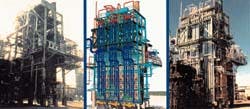Wolf Fischer
Polifin Ltd.
SasolburgPhilippe Najm
Stone & Webster Engineering Corp.
Houston
The Polifin furnace revamp project was a fast-track project, completed in less than 12 months. From left, prerevamp, 3D model, rebuilt (Fig. 1).Polifin Ltd., a producer of monomers and polymers, completed major modifications to its ethylene cracking furnace at Sasolburg, South Africa, in May 1998 ( Fig. 1 [10,425 bytes]).
The plant consists of several olefins-producing units, including utilities and other facilities within the battery limits.
The 15-year-old furnace, originally designed and built by Selas Corp. of America, was nearing the end of its useful life. Prior to shutdown for repairs, there were refractory hotspots, burner instability, and radiant tube ruptures ( Fig. 2a [6,147 bytes]Fig. 2b [8,218 bytes]).
An evaluation concluded that a major revamp was more economical than the purchase of a new furnace. A revamp would also be less of an impact on plant operations than would construction of a new furnace. The total cost of the revamp was $9.6 million.
The contract was awarded to Stone & Webster Engineering Corp. in April 1997.
Furnace scope
Stone & Webster provided furnace process design, detailed engineering and design, worldwide procurement, inspection, construction, and start-up assistance for the furnace revamp.Although a new furnace was not required, the revamp entailed the redesign and replacement of most of the furnace.
The foundation, most of the structure, and most of the instrumentation were reused. The new design specified replacement of the convection section, radiant tubes, quench exchangers, refractory, and burners.
The new ethylene furnace was designed for more than 30% more annual ethylene production than the original furnace. Actual capacity, however, increased by well over 50% because of the poor condition of the ethylene furnace prior to the revamp.
Based on ethane feed, the original furnace design capacity was 10 ton/hr. During operations, it accepted 12 tons/hr of ethane. The new furnace design is 16 tons/hr.
The old refractory, which consisted of brick and castable pieces, was replaced with ceramic-fiber modules. Although a little more expensive, the new refractory will provide improved heat resistance.
The replacement of the burners was driven by compliance with state regulations. Regulations required less than 150 ppm NOx emissions and less than 85 db noise levels. The new burners met and exceeded these requirements.
Another benefit of the new burners is the better turndown. Operators have a wider range of temperature limits with which to control the radiant box temperatures.
Demothballing two existing smaller and older furnaces was necessary to minimize the impact on production during the construction phase of the larger furnace. Each of the two furnaces has an ethane capacity of about 4.0 tons/hr, which provided about two-thirds of the normal operating cracking capacity while the large furnace was shut down.
The two furnaces needed a stack to operate. As part of the project, Polifin added a natural-draft, grade-mounted stack. The stack also allowed the future addition of a waste-heat boiler and induced-draft fan.
Technology
The Ultra Selective Conversion (USC) pyrolysis system, a Stone & Webster technology, was selected to meet the dual revamp goals of increased capacity and increased selectivity.The pyrolysis system included USC-W coils coupled to double-pipe Ultra Selective Exchanger (USXs), provided by Borsig GmbH, a subsidiary of Deutche Babcock AG. The USC-W coil is a highly selective swaged-coil design which optimizes those operating parameters influencing product yield-namely, residence time and hydrocarbon partial pressure.
The swaged-coil design enhances selectivity by shifting more of the feedstock conversion to the outlet of the coil. This shift reduces the average residence time of the products and minimizes degradation into less valuable byproducts.
The design reduces average hydrocarbon partial pressure by minimizing pressure drop in the coil system as a result of coking throughout the run cycle, further enhancing the product yields.
The USX design increases product yield and operational run time through rapid quenching and its low-coking tendency. The furnace effluent is quenched in a USX that is close coupled to the USC-W coil outlet. Unlike a conventional transfer-line heat exchanger (TLE), the USX does not have a tubesheet. Thus, the possibility of coke deposition is eliminated.
The mechanical design of the exchanger uses a unique concept, patented by Borsig, known as the turbo flow chamber. This chamber reduces inherent thermal and pressure stresses to a low level. The adiabatic volume from the radiant coil outlet to the start of effective quenching is very low, which keeps yield degradation to an absolute minimum. The USX quench exchanger will not become a run length limitation for the furnace system and does not require mechanical cleaning.
Execution
Polifin managed and executed the project from its Sasolburg site while Stone & Webster managed and executed its part from its headquarters in Houston. To achieve an aggressive project schedule, the execution required that much of the work that is usually accomplished in series be done concurrently.Although this approach caused rework, the large schedule gain, the minimal plant interruption, and the minimal loss of feed compensated for the inconveniences. As an example of the nontypical concurrent work, Polifin appointed a construction contractor before the detailed design was complete.
The demolition and construction contract was awarded to DB Thermal (Pty.) Ltd., a South African subsidiary of Deutsche Babcock. The contract for demolition and erection of equipment and its associated structures was time-and-materials based. The detailed design was not completed until after the contract was awarded.
Communication among team members had to be efficient because of the travel distance between Sasolburg and Houston, the time-zone difference of 7 hr, and the absence of Polifin and Stone & Webster personnel in each other's offices.
Electronic media was used for engineering drawings and model reviews as well as for normal mail correspondence. Electronic communication allowed Polifin, Stone & Webster, and its subcontractors and vendors to expedite reviews, changes, and approvals.
The total revamp, from engineering to the end of construction, was completed in 12 months. This included a feed-out-to-feed-in time of less than 9 weeks.
The team faced several challenges:
- Unexpected heat damage to a main structural support member was found during construction. Redesigns and repairs were done during the shutdown period.
- The simultaneous design and start-up of two smaller furnaces, previously mothballed, were done using existing drawings that were incomplete and inaccurate.
- Because there were areas that were not possible to inspect during the normal plant operations, new scopes of work were initiated during the construction phase. The evaluation of replacement of piping systems, valves, and instrumentation was time-consuming.
- The construction was performed during the rainy season in Highveld. Careful contingency planning resulted in only 4 days of lost time as a result of the rain. This affected sandblasting and painting activities.
Commissioning
As a result of the pressure to recommission the furnace to meet high ethylene demand, precommissioning checks were completed during the last phase of construction. The first burner was commissioned 6 hr after the final construction task was completed. Stone & Webster procedures were followed for dryout of the refractory and tubes.When the decoking pressure profile was attained, the furnace was ready to take ethane. This was only 3 days after completion of construction. Ethane was fed to the new furnace without any trips or trips on by-pass.
The success of the commissioning can be attributed to a dedicated and experienced commissioning team, a pretuned control loop, thorough precommissioning checks, and the phased hand-over philosophy.
Furnace operation
The furnace began operations at the beginning of May. Although the operating period is too short to evaluate factors such as furnace availability, run length, and quench-exchanger fouling, Polifin has already observed the following encouraging signs:- The unit has been remarkably stable. It has required minimal operator intervention since it started-up. Stable coil-outlet temperature, feed-flow-rates, and cracked gas composition show the stability of the plant.
- Lower, stable CO and CO2 levels in the cracked gas enable the optimization of caustic usage in the caustic-wash area.
- Noteworthy increases in total plant efficiency have occurred. The project has increased efficiency from about 84% to about 92%. This efficiency is further expected to improve as Polifin increases its load on the furnace and as the plant installs advanced process controls.
- An increased ethylene yield of 1.2% has been achieved from ethane feed despite the fact that the quality of furnace feed is much lower than design (actual ethylene slippage into the recycled ethane feed to the furnace is higher than expected)
- There is a higher-than-expected increase in ultimate ethylene yield between the current and previous operation. The Ultra Selective Radiant Coils and Ultra Selective Quench Exchangers add more value in an environment with a high ethylene partial pressure (high ethylene slippage into ethane feed).
- Increased energy efficiency of the furnace is evident because steam-generation rates from ethane feed rates have increased and because of the obvious drop in stack temperature.
- Increased capacity of the furnace is evident because there is no excess ethane feed mixed into fuel gas.
The Authors
Copyright 1998 Oil & Gas Journal. All Rights Reserved.




